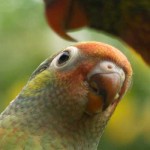WASHINGTON, April 2 (Reuters) – Dogs can catch influenza directly from birds, Korean researchers said on Wednesday, saying their finding shows pets could play a role in future pandemics.
Several pet dogs became ill and died from what turned out to be purely avian strains of seasonal flu virus, the researchers reported in the journal Emerging Infectious Diseases.
“Our data provide evidence that dogs may play a role in interspecies transmission and spread of influenza virus,” Daesub Song of Green Cross Veterinary Products Company Ltd in Yong-in, South Korea and colleagues reported.
The dogs had H3N2 influenza — a strain similar to one of the flu strains now circulating among humans. But genetic analysis showed the dogs were infected with viruses directly from birds, Song’s team said.
Doctors know animals pass flu viruses to one another. Many experts believe most, if not all, influenza viruses originate among birds.
The H5N1 avian influenza virus, which is sweeping through flocks in Asia, Africa and parts of Europe, has occasionally passed to humans, infecting 376 people and killing 238 of them. It has also occasionally infected dogs, cats, clouded leopards, civets and dozens of bird species, from swans to coots.
The fear is that it will somehow change or combine into a form that is easily passed from one human to another, sparking a pandemic that would have the potential to kill hundreds of millions of people globally.
H3N2 is found in birds and is also a very common human flu strain. But the varieties that infect birds and people look different on the genetic level.
Song’s team investigated outbreaks among dogs.
“From May through September 2007, cases of severe respiratory disease occurred in animals at three veterinary clinics located 10 to 30 km (6 to 18 miles) apart in Kyunggi Province and one kennel located in Jeolla Province (southern South Korea),” they wrote.
A miniature schnauzer recovered, but a cocker spaniel, two Korean Jindo dogs and a Yorkshire terrier died.
Another 13 dogs in a shelter were affected, and there is evidence some dogs infected others.
DNA analysis showed the viruses from the dogs closely resembled those from Chinese chickens or ducks in Hong Kong, Japan and China.
“Transmission of avian influenza A virus to a new mammalian species is of great concern because it potentially allows the virus to adapt to a new mammalian host, cross new species barriers and acquire pandemic potential,” they wrote.
They believe the dogs were infected via food.
“We posit that this transmission results from feeding dogs untreated minced meats of ducks or chickens,” they wrote.
“In South Korea, untreated duck and chicken meats, including internal organs and heads, have been widely used to feed dogs for fattening in local canine farms or kennels.”
It is possible some of the dogs were infected via respiratory secretions in live bird markets, and passed the virus to others, they added.
“Live-bird markets are thought to constitute a missing link in the epidemiology of avian influenza viruses because they bring together numerous hosts, such as chickens, ducks, turkeys, geese and doves, in a high-density setting, which represents an ideal environment for virus interspecies transmission,” they wrote. (Reporting by Maggie Fox, editing by Will Dunham and Todd Eastham)
© Reuters 2008 All rights reserved







